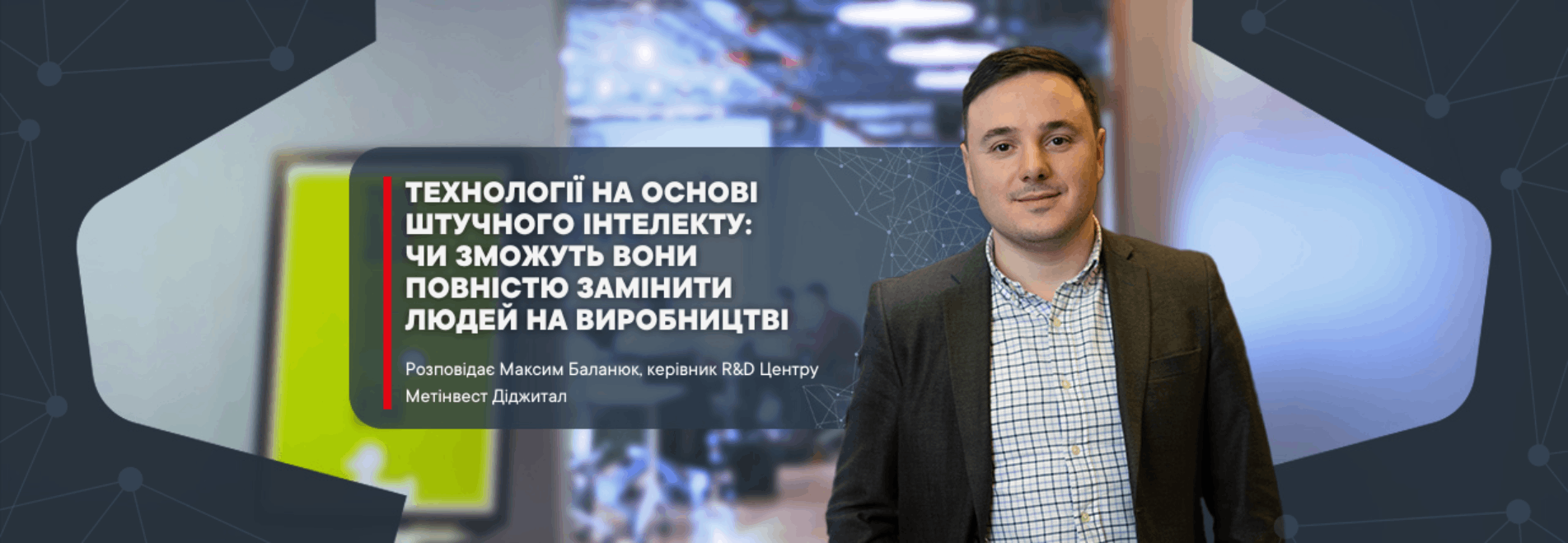Технології на основі штучного інтелекту: чи зможуть вони повністю замінити людей на виробництві
Today, the most important news in IT is that the world's most popular chatbot with artificial intelligence, Chat GPT, has started working in Ukraine. It gained 100 million users in just two months. This innovative product opens up new opportunities for quick and convenient access to information and knowledge. Not only Ukrainians, but also Ukrainian businesses became active users. But whether such technologies based on artificial intelligence (AI) will be able to completely replace people at work, we analyzed this question with Maksym Balaniuk, head of R&D at the Metinvest Digital Center.
What is artificial intelligence?
Artificial intelligence (English artificial intelligence, AI) – the ability of an engineering system to process, apply, and improve acquired knowledge and skills similar to actions performed by a human.
Will AI-based robots replace human labor in manufacturing?
When we talk about robots, this concept should be considered all mechanisms capable of performing physical or intellectual work without the participation of a person according to the algorithms assigned to them. That is, all automated processes performed without human participation – unites the concept of "robot".
The replacement of human labor with the application of AI-based technologies will primarily occur in the manufacturing sector, and this process is already underway.
Research by the Association for Advancing Automation suggests that in 2022, the number of robots that have replaced human labor in companies in the United States, Canada, and Mexico has reached an incredible scale – more than 44 thousand robots were involved.
Most of these robots were involved in production work, namely, work at enterprises producing electric cars and battery batteries, packing and sealing boxes with products, etc.
Automated machine production allows not to reduce the use of dangerous chemicals during operation, and it is also stronger and more durable than humans – does not get sick and does not require rest. This helps not to reduce working hours and not suffer losses due to the human factor.
Today, many scientists and ordinary people discuss and express their ambiguous opinion about whether it is possible to completely replace human labor in production with the labor of robots or AI. Currently, the general situation is as follows – like any progress, AI affects the disappearance of certain professions and positions in companies, but with an almost identical volume creates the same number of jobs. For example, engineers who create and maintain AI are bright representatives of such professions.
Any automation or AI allows humans to engage in more meaningful or creative activities, and robots will become our assistants.
What solutions using AI technologies does R&D Center Metinvest Digital develop for Metinvest Group?
The R&D team of the Metinvest Digital Center is quite young, but has already managed to develop several technological solutions and prototypes for our clients based on Computer Vision (CV) and Natural language processing (NLP), which can be classified as AI components.
We have a monitoring and response system for personnel in dangerous production areas (SPAIS – Staff Protection Artificial Intelligence System), virtual assistants and bots for internal support services, including for accompanying a person during onboarding to the company. Despite this, we also have other technological solutions in the field of AI, which are still waiting for their time, at the same time, research and work on the development of existing solutions and the creation of new ones are conducted by us continuously.
We are actively analyzing solutions from OpenAI and our ability to use their solutions to benefit our customers. We also have our own trained NLP models that are designed to answer various questions and perform tasks, but they are only intended for corporate use in fairly niche industries, so it is not correct to compare them with ChatGPT. However, we will see what useful things we can take from the developments of OpenAI, and most importantly – whether we can apply their solutions in work, adapting them to our needs.
Although today's AI-based technologies are becoming more sophisticated and can do some things better than humans, they still lack the ability to think for themselves, solve problems that require a creative approach, and make decisions the way humans do. Therefore, it is unlikely that they will be able to completely replace a person in the near future, although any automation of production processes greatly helps people in their work.




